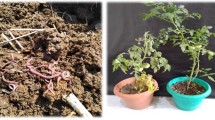Summary
Field, glasshouse and laboratory studies were conducted to examine the degree of phytotoxicity and any differential phytotoxicity among residues of the genus Brassica usingTriticum aestivum as the test species. Compared to water controls, aqueous extracts of thirteen Brassica residues from six species ranged in inhibition from 56.7% to 91.4% for coleoptile growth and 59.1% to 97.8% for root growth. Based on the aqueous extract screening, six cultivars representing four species were used in a field experiment which showed significant differences among cultivars and species. All residues reduced grain yield, plant dry weight, plant height and tiller production in wheat. Increasing levels of inhibition occurred fromB. campestris cv. Torch,B. juncea cv. Zem 1,B. napus cv. Wesroona,B. nigra cv. Vince,B. juncea cvs. Lethbridge 22A and Zem 2. There are significant positive correlations for the ranked cultivars among the parameters measured in each trial and among trials. Laboratory studies indicated that field residues, stored dry, became less toxic over time and that increasing humidity appeared to increase the rate of decay of activity.
Similar content being viewed by others

References
Bell D 1970 Allelopathic effect ofBrassica nigra on annual grasslands. Ph.D. thesis, University of California, Santa Barbara.
Bell D T, Muller C H 1973 Dominance of California annual grasslands byBrassica nigra. Am. Midland Nat. 90 (2), 277–299.
Campbell A G 1959 A germination inhibitor and root growth retarder inB. oleracea var. Chou Moellier. Nature 183, 1263–1264.
Fay P K and Duke W B 1977 An assessment of allelopathic potential inAvena germ plasm. Weed Sci. 25, 224–228.
Guenzi W D, McCalla T M, Norstadt F A 1967 Presence and persistence of phytotoxic substances in wheat, oat, corn and sorghum residues. Agron. J. 59, 163–165.
Grummer G 1961 The role of toxic substances in the interrelationships between higher plants. Symp. Soc. Exp. Bio. 15, 219–228.
Harper S H T and Lynch J M 1982 The role of water-soluble components in phytotoxicity from decomposing straw. Plant and Soil 65, 11–17.
Horricks J 1969 Influence of rape residues on cereal production. Can. J. Pl. Sci. 49, 632–634.
Jessop, R S and Stewart L S 1983 Effects of crop residues, soil type and temperature on emergence and early growth of wheat. Plant and Soil 74, 101–111.
Kimber R W L 1967 Phytotoxicity from plant residues. I. The influence of rotted wheat straw on seedling growth. Aust. J. Agric. Res. 18, 361–374.
Leather, G R 1983 Sunflowers (Helianthus annuus) are allelopathic to weeds. Weed Sci. 31, 37–42.
Lockerman R H and Putnam A R 1979 Evaluation of allelopathic cucumbers as an aid to weed control. Weed Sci. 27, 54–57.
Lockerman R H and Putnam A R 1981 Mechanisms for differential interference among cucumber cultivar pioneer accessions. Bot. Gaz. 142, 427–430.
McCalla T M and Norstadt F A 1974 Toxicity problems in mulch tillage. J. Agric. Env. 1, 153–174.
Neal J L 1973 Effect of rape on accumulation of nitrate in soil. Weekly Letter No. 2057, Lethbridge Res. Stn., Alberta, Canada.
Parr J F, Papendick R I 1978 Factors affecting the decomposition of crop residues by micro-organisms. In Crop Residue Management Systems, ASA Special Publication No. 31, 1978, Madison, Wisconsin.
Putnam A R and Duke W B 1974 Biological suppression of weeds: evidence for allelopathy in accessions of cucumbers. Sci. 185, 370–372.
Patrick A A 1971 Phytotoxic substances associated with the decomposition in soil of plant residues. Scil Science 111, 13–18.
Rice E L 1984 Allelopathy. 2nd Edn. Academic Press, New York.
Rose S J, Burnside O C, Specht J E and Swisher B A 1984 Competition and allelopathy between soybeans and weeds. Agron. J. 76, 523–528.
Steele R G D, Torrie J H 1980 Principles and procedures of statistics. 2nd Edn., McGraw-Hill, Kogakusha, Ltd., Japan.
Stowe L G 1979 Allelopathy and its influence on the distribution of plants in an Illionois old-field. J. Ecol. 67, 1067–1085.
Stringham G R 1971 Genetics of four hypocotyl mutans inB. campestris J. Hered. 62, 248–250.
Vera C L 1981 Adverse effect ofBrassica species on subsequent crops. M.Sc. thesis, University of Saskatoon, Saskatchewan, Canada.
Waddington J and Bowren K E 1978 Effect of crop residue on production of barley, bromegrass and alfalfa in the greenhouse and in the field. Can. J. Pl. Sci. 58, 249–255.
Author information
Authors and Affiliations
Rights and permissions
About this article
Cite this article
Mason-Sedun, W., Jessop, R.S. & Lovett, J.V. Differential phytotoxicity among species and cultivars of the genusBrassica to wheat. Plant Soil 93, 3–16 (1986). https://doi.org/10.1007/BF02377141
Received:
Accepted:
Issue Date:
DOI: https://doi.org/10.1007/BF02377141



